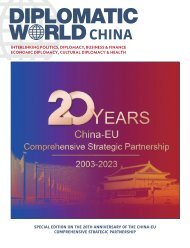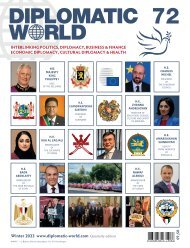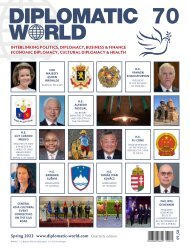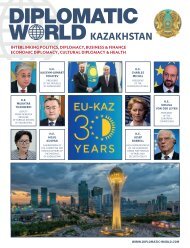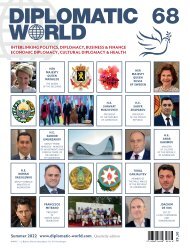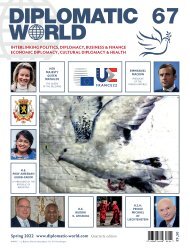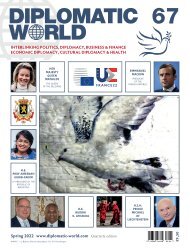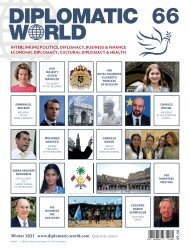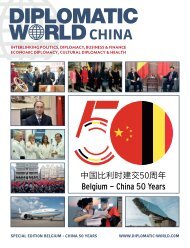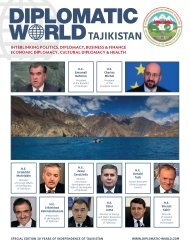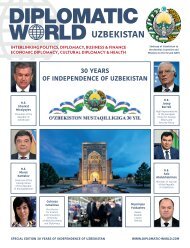Diplomatic World_69
You also want an ePaper? Increase the reach of your titles
YUMPU automatically turns print PDFs into web optimized ePapers that Google loves.
From an environmental point of view, rail freight is simply the<br />
“… the Middle Corridor is no longer just an alternative transit<br />
most sustainable mode of transport. Comparing the CO2 emis-<br />
route, it is an indispensable necessity. Moreover, to overcome<br />
sions of air, sea, road, and rail freight shows that rail, especially<br />
infrastructure dependence on Russia, the EU also needs the<br />
considering the speed of transport, is the most eco-friendly<br />
Middle Corridor as an alternative route.” (https://jamestown.org/<br />
choice.<br />
program/first-trilateral-meeting-of-the-ministers-of-turkiyeazerbaijan-and-kazakhstan/)<br />
Additionally, rail freight containers and trailers are also compatible<br />
with road freight. This multimodal transport is very efficient,<br />
since the container or trailer can be transferred from train to truck<br />
and vice versa without difficulty, thus avoiding the need to unload<br />
OPPORTUNITIES FOR CENTRAL ASIA<br />
and re-load the cargo at transit points.<br />
Rhenus already started looking at the Middle Corridor one and<br />
a half years ago. At that time, a route bypassing Russia was<br />
WITH THE ONGOING DISRUPTIONS TO THE<br />
NORTHERN CORRIDOR, MANY LOGISTICS<br />
COMPANIES HAVE SHIFTED SERVICES TO<br />
THE TRANS-CASPIAN INTERNATIONAL TRANS-<br />
PORT ROUTE, RUNNING FROM EAST ASIA VIA<br />
KAZAKHSTAN, THE CASPIAN SEA, AZERBAIJAN,<br />
GEORGIA AND ONWARDS TO EUROPE. HOW HAS<br />
THE RHENUS GROUP ADJUSTED TO THIS NEW<br />
REALITY; AND WHAT CAN BE DONE TO INCREASE<br />
THE VOLUME AND CAPACITY OF THE MIDDLE<br />
CORRIDOR?<br />
not of paramount importance. The company was driven by the<br />
realisation that their Europe-Asia transports with the connection<br />
between Xi’an and Duisburg involved a 12,000-kilometre drive<br />
through Siberia. The Middle Corridor, in comparison, offers an<br />
opportunity to connect the economies of Central Asia with the<br />
economic areas of Europe and China, as well as linking the<br />
countries of Central Asia with reliable high-performance logistics<br />
chains. The transport means of choice in these countries today<br />
is the truck, which often ensures the exchange of goods in the<br />
Central Asian region over thousands of kilometres. This is good<br />
and important, but it needs to be complemented by rail. Today,<br />
for example, freight from Central Asia to Europe costs four to<br />
five times as much as transport from China (Shanghai) to Europe<br />
The ongoing war in Ukraine has given rise to many problems in<br />
(Rotterdam). With better and cheaper connections, the eco-<br />
different areas and industries. One of these problems is the or-<br />
nomic development of the Central Asian countries will certainly<br />
ganisation of new logistic routes between Asia and Europe. The<br />
progress faster.<br />
route via Russia and Belarus, which served as a major corridor<br />
and facilitate its use as the main transport route, Central Asian<br />
transfer between rail and ship. The necessary electrified tracks<br />
between the EU and China for nearly a decade, is facing troubles<br />
According to the estimates of the Trans-Caspian International<br />
countries have been investing billions of dollars in infrastructure<br />
have to be built; in this respect sensitive gaps have arisen in<br />
as sanctions imposed on Moscow make trade companies fearful<br />
Transport Route Association (TITR), which is composed of the<br />
projects.<br />
recent decades, especially in Armenia.<br />
of potential negative economic effects, such as security and<br />
major state transportation companies in the region, the volume<br />
insurance issues. Thus, the Trans-Caspian Transport Route, also<br />
of freight passing through Central Asia and the Caucasus will<br />
All countries involved in the development of the Middle Corridor<br />
In Georgia, the port facilities on the Black Sea will be expanded<br />
known as the Middle Corridor, is emerging as a good alternative<br />
increase to 3.2 million metric tons in 2022, which denotes a<br />
need to constantly improve the transportation process and<br />
to a capacity of approximately one million TEU from 2027. Unfor-<br />
for the future.<br />
growth of six times the volume compared to the previous year.<br />
increase the competitiveness of the railway route. For example,<br />
tunately, Kazakhstan’s plans for the port of Aktau on the Caspian<br />
Whilst providing a good option to avoid passing through Russia,<br />
Azerbaijan is actively working on expanding its logistics capac-<br />
Sea are too tentative. Plans for the new container terminal in<br />
The US think tank The Jamestown Foundation clearly highlighted<br />
the Middle Corridor currently only has about five percent of the<br />
ities, and has set itself the target of transporting up to 500,000<br />
Aktau, for example, currently envisage a capacity of ‘only’<br />
the importance of the Middle Corridor in mid-July 2022:<br />
northern route’s capacity. To develop the corridor’s capacity<br />
TEU via the Middle Corridor in 2026/2027.<br />
100,000 TEU. However, both the Caspian Sea and the Black<br />
Sea have the potential to be the future gateways to Europe.<br />
BOTTLENECKS<br />
The trend towards constant development, the creation of new<br />
capacities, including terminals and transhipment / rail gauge<br />
Nevertheless, much still has to be done in order for the Middle<br />
transfer facilities and the implementation of digital solutions, is<br />
Corridor, with its many border crossings, to achieve the neces-<br />
crucial for the route itself, as well as for the whole broad-gauge<br />
sary performance on the Caspian Sea and, to a lesser extent,<br />
(1520 mm) area. If high speed is achieved in one section, but at<br />
on the Black Sea. Further challenges are the need to switch<br />
the same time there are difficulties in the sections of connected<br />
between broad gauge (1520 mm) and standard gauge (1435 mm)<br />
infrastructure, all efforts are wasted. That is why the integration<br />
rail tracks, as well as the change of transport mode between<br />
of key players along this route is more essential than ever.<br />
rail and ship. In addition, at least on the Caspian Sea shipping<br />
capacities need to be adapted to the expected freight volumes.<br />
www.rhenus.group<br />
Additional transhipment facilities are needed to switch between<br />
rail gauges, as are container-optimised port facilities for the<br />
138 139





